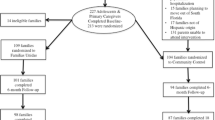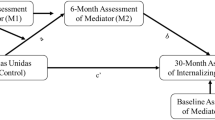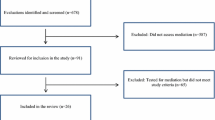Abstract
Prevention programs that strengthen parenting and family functioning have been found to reduce poor behavioral outcomes in adolescents, including substance use, HIV risk, externalizing and internalizing problems. However, there is evidence that not all youth benefit similarly from these programs. Familias Unidas is a family-focused intervention designed to prevent substance use and sexual risk among Hispanic youth and has recently demonstrated unanticipated reductions in internalizing symptoms for some youth. This paper examines variation in intervention response for internalizing symptoms using individual-level data pooled across four distinct Familias Unidas trials: (1) 266 eighth grade students recruited from the general school population; (2) 160 ninth grade students from the general school population; (3) 213 adolescents with conduct, aggression, and/or attention problems; and (4) 242 adolescents with a delinquency history. Causal inference growth mixture modeling suggests a three-class model. The two largest classes represent youth with low (60 %) and medium (27 %) internalizing symptoms at baseline, and both intervention and control participants show reductions in internalizing symptoms. The third class (13 %) represents youth with high levels of baseline internalizing symptoms who remain at steady levels of internalizing symptoms when exposed to the intervention, but who experience an increase in symptoms under the control condition. Female gender, low baseline levels of parent–adolescent communication, and older age were associated with membership in the high-risk class. These synthesis analyses involving a large sample of youth with varying initial risk levels represent a further step toward strengthening our knowledge of preventive intervention response and improving preventive interventions.


Similar content being viewed by others
References
Adams, R. N., Mosher, C. E., Blair, C. K., Snyder, D. C., Sloane, R., & Demark‐Wahnefried, W. (2015). Cancer survivors’ uptake and adherence in diet and exercise intervention trials: An integrative data analysis. Cancer, 121, 77–83.
Avenevoli, S., Swendsen, J., He, J. P., Burstein, M., & Merikangas, K. R. (2015). Major depression in the National Comorbidity Survey- Adolescent Supplement: Prevalence, correlates, and treatment. Journal of the American Academy of Child & Adolescent Psychiatry, 54, 37–44.
Barnes, H. L., & Olson, D. H. (1985). Parent-adolescent communication and the circumplex model. Child Development, 56, 438–447.
Biglan, A., Flay, B. R., Embry, D. D., & Sandler, I. N. (2012). The critical role of nurturing environments for promoting human well-being. American Psychologist, 67, 257-71.
Brown, C. H., Sloboda, Z., Faggiano, F., Teasdale, B., Keller, F., Burkhart, G., Vigna-Tagliant, F., Howe, G., Masyn, K., Wang, W., Muthén, B., Stephens, P., Grey, S., & Perrino, T. (2013). Methods for synthesizing findings on moderation effects across multiple randomized trials. Prevention Science, 14, 144–156.
Cervantes, R. C., Padilla, A. M., & Salgado de Snyder, N. (1991). The Hispanic Stress Inventory: A culturally relevant approach to psychosocial assessment. Psychological Assessment, 3, 438–447.
Curran, P. J., & Hussong, A. M. (2009). Integrative data analysis: The simultaneous analysis of multiple data sets. Psychological Methods, 14, 81.
Estrada, Y., Rosen, A., Huang, S., Tapia, M., Sutton, M., Willis, L., et al. (2015). Efficacy of a brief intervention to reduce substance use and Human Immunodeficiency Virus infection risk among Latino youth. Journal of Adolescent Health, 57(6), 651–657.
Garber, J. (2006). Depression in children and adolescents: Linking risk research and prevention. American Journal of Preventive Medicine, 31, 104–125.
Greenbaum, P. E., Wang, W., Henderson, C. E., Kan, L., Hall, K., Dakof, G. A., & Liddle, H. A. (2015). Gender and Ethnicity as Moderators: Integrative Data Analysis of Multidimensional Family Therapy Randomized Clinical Trials. Journal of Family Psychology. Advance online publication. http://dx.doi.org/10.1037/fam0000127.
Horowitz, J. L., & Garber, J. (2006). The prevention of depressive symptoms in children and adolescents: A meta-analytic review. Journal of Consulting and Clinical Psychology, 74, 401–15.
Horwood, L. J., Fergusson, D. M., Coffey, C., Patton, G. C., Tait, R., Smart, D., & Hutchinson, D. M. (2012). Cannabis and depression: An integrative data analysis of four Australasian cohorts. Drug and alcohol dependence, 126, 369–378.
Hovey, J. D., & King, C. A. (1996). Acculturative stress, depression, and suicidal ideation among immigrant and second-generation Latino adolescents. Journal of the American Academy of Child & Adolescent Psychiatry, 35, 1183–1192.
Hussong, A. M., Curran, P. J., & Bauer, D. J. (2013). Integrative data analysis in clinical psychology research. Annual Review of Clinical Psychology, 9, 61.
Ingoldsby, E. M., Kohl, G. O., McMahon, R. J., Lengua, L., & the Conduct Disorders Prevention Research Group. (2006). Conduct problems, depressive symptomatology and their co-occurring presentation in childhood as predictors of adjustment in early adolescence. Journal of Abnormal Psychology, 34, 603–21.
Jo, B., Wang, C. P., & Ialongo, N. S. (2009). Using latent outcome trajectory classes in causal inference. Statistics and Its Interface, 2, 403–12.
Kessler, R. C., Avenevoli, S., Costello, J., Green, J. G., Gruber, M. J., McLaughlin, K. A., & Merikangas, K. R. (2012). Severity and 12-month DSM-IV disorders in the National Comorbidity Survey-Adolescent Supplement. Archives of General Psychiarty, 69, 381–9.
Kessler, R. C., Berglund, P., Demler, O., Jin, R., Merikangas, K. R., & Walters, E. E. (2005). Lifetime prevalence and age-of-onset distributions of DSM-IV disorders in the National Comorbidity Survey Replication. Archives of General Psychiatry, 62, 593–602.
Merry, S. N., Hetrick, S. E., Cox, G. R., Brudevold-Iversen, T., Bir, J. J., & McDowell, H. (2011). Psychological and educational interventions for preventing depression in children and adolescents. Cochrane Database Systematic Reviews, 12. doi: 10.1002/14651858.CD003380.pub3.
Mun, E. Y., de la Torre, J., Atkins, D. C., White, H. R., Ray, A. E., Kim, S. Y., & Huh, D. (2014). Project INTEGRATE: An integrative study of brief alcohol interventions for college students. Psychology of Addictive Behaviors, 29, 34–48.
Muthén, B., & Brown, C. H. (2009). Estimating drug effects in the presence of placebo response: Causal inferences using growth mixture modeling. Statistics in Medicine, 28, 3363–3385.
Muthén, B., Brown, H., Leuchter, A., & Hunter, A. (2008). General approaches to analysis of course: Applying growth mixture modeling to randomized trials of depression medication. In P. E. Shrout (Ed.), Causality and psychopathology: Finding the determinants of disorders and their cures. Washington, DC: American Psychiatric Publishing.
Neumark-Sztainer, D., Larson, N. I., Fulkerson, J. A., Eisenberg, M. E., & Story, M. (2010). Family meals and adolescents: what have we learned from Project EAT (Eating Among Teens)? Public health nutrition, 13, 1113–1121.
NRC/IOM- National Research Council/Institute of Medicine. (2009). Committee on the Prevention of Mental Disorders and Substance Abuse among Children. In M. O’Connell, T. Boat, & K. Warner (Eds.), Preventing mental, emotional, and behavioral disorders among young people: Progress and possibilities. Washington, DC: National Academies Press.
Pantin, H., Prado, G., Lopez, B., Huang, S., Tapia, M. I., Schwartz, S. J., & Branchini, J. (2009). A randomized controlled trial of Familias Unidas for Hispanic adolescents with behavior problems. Psychosomatic Medicine, 71, 987–95.
Perrino, T., Brincks, A., Howe, G., Brown, C. H., Prado, G., & Pantin, H. (2016). Reducing internalizing symptoms among high-risk, Hispanic adolescents: Mediators of a family intervention. Prevention Science, 17, 595–605.
Perrino, T., Pantin, H., Prado, G., Huang, S., Brincks, A., Howe, G., & Brown, C. H. (2014). Preventing internalizing symptoms among Hispanic adolescents: A synthesis across Familias Unidas trials. Prevention Science. Epub ahead of print.
Prado, G., Pantin, H., Briones, E., Schwartz, S. J., Feaster, D., Huang, S., & Szapocznik, J. (2007). A randomized controlled trial of a parent-centered intervention in preventing substance use and HIV risk behaviors in Hispanic adolescents. Journal of Consulting and Clinical Psychology, 75, 914–26.
Prado, G., Pantin, H., Huang, S., Cordova, D., Tapia, M. I., Velazquez, M. R., & Estrada, Y. (2012). Effects of a family intervention in reducing HIV risk behaviors among high-risk Hispanic adolescents: A randomized controlled trial. Archives of Pediatrics & Adolescent Medicine, 166, 127–133.
Quay, H. C., & Peterson, D. R. (1993). The Revised Behavior Problem Checklist: Manual. Odessa, FL: Psychological Assessment Resources.
Restifo, K., & Bögels, S. (2009). Family processes in the development of youth depression: Translating the evidence to treatment. Clinical Psychology Review, 29, 294–316.
Rueter, M. A., Scaramella, L., Wallace, L. E., & Conger, R. D. (1999). First onset of depressive or anxiety disorders predicted by longitudinal course of internalizing symptoms and parent-adolescent disagreements. Archives of General Psychiatry, 56, 726–32.
Saluja, G., Iachan, R., Scheidt, P. C., Overpeck, M. D., Sun, W., & Giedd, J. N. (2004). Prevalence of and risk factors for depressive symptoms among young adolescents. Archives of Pediatric & Adolescent Medicine, 158, 760–5.
Sandler, I., Schoenfelder, E., Wolchik, S., & MacKinnon, D. (2011). Long-term impact of prevention programs to promote effective parenting: Lasting effects but uncertain processes. Annual Review of Psychology, 62, 299–329.
Sandler, I., Wolchik, S. A., Cruden, G., Mahrer, N. E., Ahn, S., Brincks, A., & Brown, C. H. (2014). Overview of meta-analyses of the prevention of mental health, substance use, and conduct problems. Annual Review of Clinical Psychology. Epub ahead of Print.
Schafer, J. L. (1997). Analysis of incomplete multivariate data. Boca Raton: CRC press.
Stice, E., Shaw, H., Bohon, C., Marti, C. N., & Rohde, P. (2009). A meta-analytic review of depression prevention programs for children and adolescents: Factors that predict magnitude of intervention effects. Journal of Consulting and Clinical Psychology, 77, 486–503.
Tein, J. Y., Sandler, I. N., MacKinnon, D. P., & Wolchik, S. A. (2004). How did it work? Who did it work for? Mediation in the context of a moderated prevention effect for children of divorce. Journal of Consulting and Clinical Psychology, 72, 617–24.
Thomas, A., Forehand, R., Armistead, L., Wierson, M., & Fauber, R. (1990). Cross-informant consistency in externalizing and internalizing problems in early adolescence. Journal of Psychopathology and Behavioral Assessment, 12, 255–62.
Trudeau, L., Spoth, R., Randall, G. K., Mason, W. A., & Shin, C. (2012). Internalizing symptoms: Effects of a preventive intervention on developmental pathways from early adolescence to young adulthood. Journal of Youth and Adolescence, 41, 788–801.
Wang, C. P., Brown, C. H., & Bandeen-Roche, K. (2005). Residual diagnostics for growth mixture models: Examining the impact of a preventive intervention on multiple trajectories of aggressive behavior. Journal of the American Statistical Association, 100, 1054–76.
Wesselhoeft, R., Sørensen, M. J., Heiervang, E. R., & Bilenberg, N. (2013). Subthreshold depression in children and adolescents–a systematic review. Journal of Affective Disorders, 151, 7–22.
Wolffe, J. C., & Ollendick, T. H. (2006). The comorbidity of conduct problems and depression in childhood and adolescence. Clinical Child and Family Psychology Review, 9, 201–20.
Zahn-Waxler, C., Klimes-Dougan, B., & Slattery, M. J. (2000). Internalizing problems of childhood and adolescence: Prospects, pitfalls, and progress in understanding the development of anxiety and depression. Development & Psychopathology, 12, 443–66.
Author information
Authors and Affiliations
Corresponding author
Ethics declarations
Funding
This work was supported by the following grants: National Institute of Mental Health Grant No. R01MH040859 (C. Hendricks Brown, PI); National Institute of Mental Health Grant No. R01MH61143 (Jose Szapocznik, PI); National Institute on Drug Abuse Grant No. R01DA017462 (Hilda Pantin, PI); National Institute on Drug Abuse Grant No. R01DA025894 (Guillermo Prado, PI); Centers for Disease Control and Prevention Grant No. U01PS000671 (Guillermo, Prado, PI).
Conflicts of Interest
The authors declare that they have no conflict of interest.
Statement of Human Rights
All procedures performed in the original studies involving human participants were in accordance with the ethical standards of the institutional and/or national research committee and with the 1964 Helsinki Declaration and its later amendments or comparable ethical standards. For this type of study, synthesizing data across multiple, completed randomized clinical trials, formal consent is not required.
Rights and permissions
About this article
Cite this article
Brincks, A., Perrino, T., Howe, G. et al. Preventing Youth Internalizing Symptoms Through the Familias Unidas Intervention: Examining Variation in Response. Prev Sci 19 (Suppl 1), 49–59 (2018). https://doi.org/10.1007/s11121-016-0666-z
Published:
Issue Date:
DOI: https://doi.org/10.1007/s11121-016-0666-z




